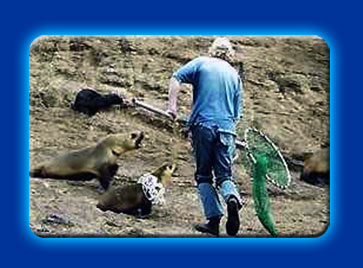Entanglement research
Scientists are trying to minimise the number of seals that get entangled. They record the numbers of seals that get entangled at Seal Rocks and record the type of material that the seals are getting entangled in. This information is passed on to people in government departments, fishing industries and other relevant organisations that help manage the marine environment. Knowing what sort of material entangles seals and how it could be getting into the ocean helps us find ways to reduce the problem.
Scientists studying seals put in a lot of time and effort to help entangled seals. They try to catch the seals and cut the material off. They must be very careful though, as chasing one entangled seal disturbs all the other seals. The startled seals wake up, pups stop suckling and all the seals stampede to the water. Frightened seals may even try to bite the researchers.
Once an entangled seal is caught, the scientists cut off the debris. The seal does not realise the scientists want to help, so it tries to bite the scientists and escape. When a tight piece of debris is cut away a seal will almost sigh in relief.
The seal is released and it runs away into the water. Seals can even recover from quite severe wounds.













